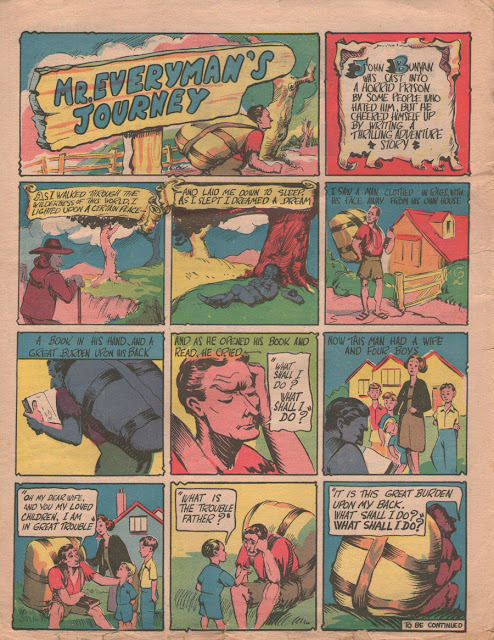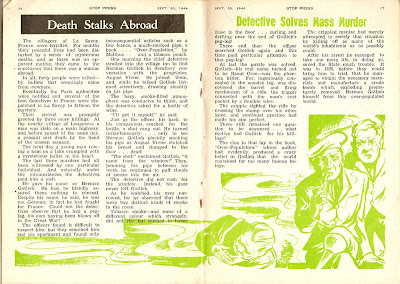During correspondence with Herge in his late teens, New Zealand Cartoonist Tim Bollinger announced to Herge he would be popping over for a visit and embarked on an ocean-liner voyage to meet his comic-hero in Belgium. Herge was elderly and unwell at the time and Bollinger was unable to see him but did visit his studio and spend time with Herge's Secretary Alain Baran. Baran encouraged Bollinger not to let geography be a barrier to the making of comics.
Tim Bollinger has been active in the New Zealand comics scene since he was 17 with his initial contributions to Wellington student Newspaper, Salient, (Joe Sputnik & the Mystery of Ravioli's Father). Through the eighties and nineties Bollinger produced over a dozen comics and many contributions to anthologies, newspapers, magazines and educational material.
Stories Strange But None The Less True (1981)
For a time Bollinger served as an editor and cartoonist for Tearaway magazine (a free monthly for young people) which also featured work by notable New Zealand cartoonists Toby Morris, Willi Saunders and Dylan Horrocks.
Back of Beyond is the title of a New Zealand comics history volume that Bollinger has been researching and writing for over 20 years. With a long standing interest in the history of New Zealand comics and cartoonists, Bollinger has managed to record many aspects of the local industry that would have otherwise been lost to time.
Bollinger has also curated and contributed to exhibitions examining historical aspects of New Zealand comics. Notably 'The Work of H.W Bennett' and 'NZ Comix in the '70s' both held during New Zealand Comics Weekend in Wellington April, 2010. Adrian Kinnaird's blog has coverage here.
Noah from White Fungus Magazine #9 (2008)
The following interview was conducted via email over February and March 2012.
When and what were the first New Zealand comics you encountered?
The first comic book that I consciously remember noting as a New Zealand-drawn comic was in the late 1970s at Printed Matter Bookshop on Plimmer's Steps in Wellington. It was a copy of 'Strips' No. 3, with a cover by Dick Frizzell (who I'd never heard of before back then). I think it had a cover price of 80 cents.I guess before this, I'd encountered all the strips that ran in the NZ Listener (Murray Ball had some strips before Footrot Flats like 'Kids' and 'Stanley' and he had some predecessors in there as well), but my real interest was in longer comic narratives. My favourite comics at the time were Tintin, Asterix and Donald Duck.
Even though it presented itself as a kind of fanzine, 'Strips' was a real comic book. The thing that struck me most about it was how good all the artwork was, from Flexible Shaft's 'Maureen Cringe', through to Colin Wilson's carefully crafted European-style adventure stories. All were really well drawn in completely different but equally unique styles. All of the artists' lines were really thick and clear, with lots of interesting pointalist and other black and white inking techniques that helped to create depth and tone, with lots of strong flat blacks. To this day, I think clarity of line and image remains a characteristic feature of many local comics.
Yet despite the slick artwork, it had a real underground feeling about it too - for a start it was in black and white - but it also had a radical, hippie bent that seemed to allow for freedom expression in the sexual, political and experimental comics of the likes of Barry Linton, Laurence Clark and others.Compared to most of the other underground comics I'd seen, and Printed Matter carried a few, given that the store at that time was being managed by Leo Hupert, who ended up founding VMS (Visual Media Services) which later became 'Graphic' (in the Cuba Mall, Wellington), 'Strips' was a really well-put-together book. It included comics criticism and historical reviews as well as strips (Australian comics historian John Ryan even had a column). I committed the comic's Waiheke Island publishing address to memory: Wilma Road, Ostend.
Strips #1 - Cover by Colin Wilson
The other thing that I took mental note of was the type of ink drawing pen depicted by Colin Wilson in his strip on the inside back page. It was an 0.5 Rotring Rapidograph - a refillable tech pen favoured by architectural draftsmen of the era. I went straight out and bought one, and that's what I used to draw all my comics with until Rotring discontinued the model in favour of, firstly the refill cartridge-based Isograph, and then, for the fully disposable one-piece Rotring ready-made fit-for-the-landfill each time the barrel's emptied - I guess the manufacturers finally figured that us cartoonists weren't contributing our share to the devastation of the planet - now all that's changed. Each one might as well be the barrel of a loaded gun, and I no longer draw with an easy conscience.
Who were the first local comics creators you encountered?
These were the artists I first consciously encountered (on paper). Encountered in real life, well...I never actually got a comic book of my own printed and (self-) published till 1981-2 - 'Stories Strange But None-the-less True'. I sent a copy to 'Strips' to review. They did. Then I visited them during a distribution trip to Auckland. Back then there were no comic shops, so you circulated them however you could, through University bookshops, and second hand record and magazine stores, like the one in St. Kevin's Arcade, which I know is where the likes of Cornelius Stone first picked up copies.
On that trip, I met Laurence Clark, Barry Linton and one or two others. Barry made the biggest impression on me, and despite long intervals between meetings, it's been a life-long friendship.
What sparked your interest in researching and writing about New Zealand Comics? and when did you start work in earnest on Back of Beyond?
Ah well. I did a politics degree. It was a lot of hard work, but I developed some skills. Delving, fossicking, researching, writing, reference-checking, cold-calling, fronting up, conducting interviews and recording and transcribing them. I was doing some research into Foreign Investment in New Zealand, sponsored as things were in the new corporate world of the early 1990s by Tradenz, a government qwango that wanted me to prove how good it was for the New Zealand economy. I'd pretty much figured out that it wasn't.
So, almost without even thinking around the end of 1991, I started to apply these same academic techniques to everything I could find out about locally drawn comics. I had in mind a book I called 'Back of Beyond' which would document all the great comics I'd seen published over the years in my lifetime. It was a great idea. I got in touch with all the usual suspects, most of whom I'd never met, but whose work I'd seen through the 80s and 90s: Chris Knox, Dylan Horrocks, Cornelius Stone, and the Langridge brothers in Auckland; Peter Rees, Lars Cawley and Ian Dalziel in Christchurch;
Tim Cornelius, Anthony Behrens, Robert Scott and Tony Renouf in Dunedin.
Noah from White Fungus Magazine #9 (2008)
But there was another strand that I hadn't counted on. I knew of no New Zealand comics from before the 1970s, but I wanted to include and document any in my book if I could find some. So I went to visit a well-known Wellington antiquarian who used to reside at the top of Cuba Street (pre-Bypass) above a Victorian villa turned into a junk shop, called 'Mr. Smiles'. I knocked on his door. He answered. When I asked him about New Zealand comics, he mentioned 'Strips'. He said that he remembered a comic book published back in the early 80s by a guy called Tim Bollinger. I said that was me. I said I wanted to find some really old stuff. He had a bit more of a think, and then he said he thought he might have one or two things in his collection. He took me upstairs and pulled out a bunch of old comic books, among them a slightly amateur-looking Buck Rogers imitation called Crash Carson that immediately jumped out as a New Zealand comic book because of a little kiwi stamp imprinted at the end of each row of panels with the letters: EANDI. This was the signature of the artist Eric Resetar (behind which there's a story that I'll tell in my book...when I get round to finishing it!). The comics had been sent to Mr. Smiles (Possibly from Sam's Book Exchange), with an accompanying note explaining their origin, and summarising Eric and his brother's publishing achievements as children in the early 1940s.

Attitude Problem #2 (1995)
There was no address, but Resetar was not a difficult name to track down in the Auckland telephone directory. I think Mr Smiles might have given me Geoff Harrison's contact too. Harrison has also written about early New Zealand comics, and probably has some of the best knowledge of what was published in New Zealand before the 1960s and 70s. Anyway, that's how I got started.








































